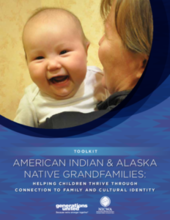Both inside and outside the foster care system, American Indian and Alaska Native children are more likely to live in grandfamilies—families in which grandparents, other adult family members or close family friends are raising children with no parents in the home—than any other racial or ethnic group.
Over the last few decades, drug epidemics, natural disasters and other tragedies have both created grandfamilies and challenged existing ones. The COVID-19 pandemic is the latest crisis to have elevated the needs of these families, and in particular the needs of American Indian and Alaska Native families, who are being disproportionally impacted by the pandemic. The rates of infection and death are staggering. For example, as of early May 2020 in the Navajo Nation, the mortality and infection rates are higher than the vast majority of states.
This toolkit is designed to give resources and tips to child welfare agencies, other government agencies and nonprofit organizations, so they can better serve all American Indian and Alaska Native grandfamilies regardless of child welfare involvement. It will explore some unique strengths and challenges of these grandfamilies, which agencies and organizations need to recognize in order to provide culturally appropriate supportive services.

